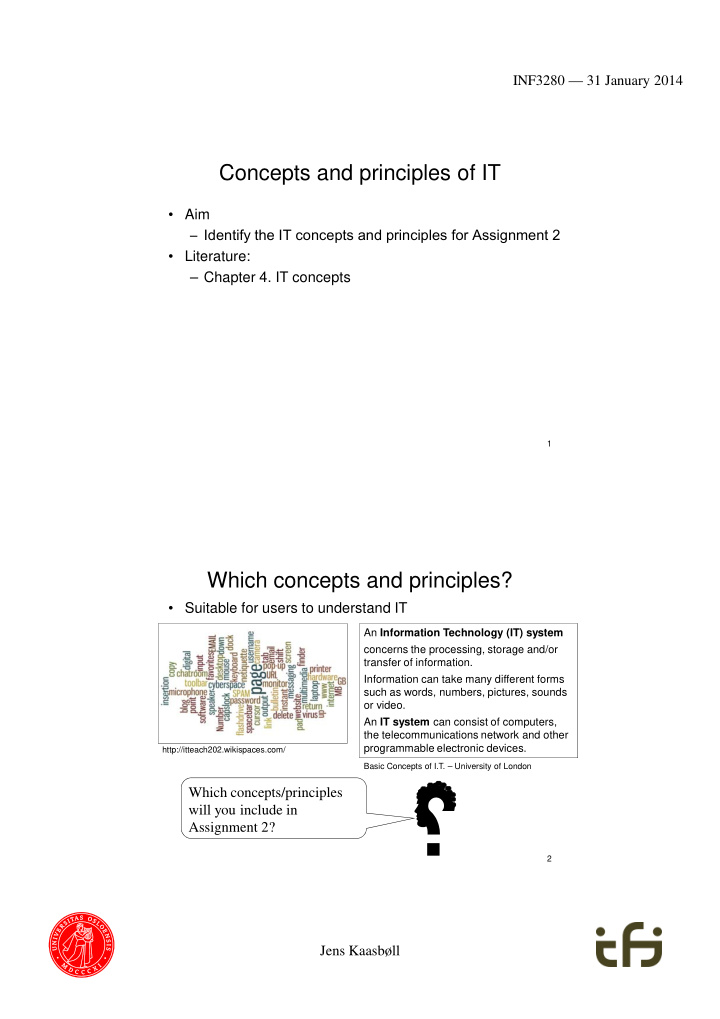



INF3280 — 31 January 2014 Concepts and principles of IT • Aim – Identify the IT concepts and principles for Assignment 2 • Literature: – Chapter 4. IT concepts 1 Which concepts and principles? • Suitable for users to understand IT An Information Technology (IT) system concerns the processing, storage and/or transfer of information. Information can take many different forms such as words, numbers, pictures, sounds or video. An IT system can consist of computers, the telecommunications network and other programmable electronic devices. http://itteach202.wikispaces.com/ Basic Concepts of I.T. – University of London Which concepts/principles c will you include in Assignment 2? 2 Jens Kaasbøll
INF3280 — 31 January 2014 Computers – Sequence • Manipulating symbols • Automatic • Computationally universal – All finite calculations – Replace all special IT • Turing completeness Alan Turing ENIAC 1946 • Automatic and universal • Programs stored by plugging cables 3 U.S. Army Photo Structure: the von Neumann architecture Computers • Programs stored in the same way as data • von Neumann architecture János Lajos Margittai Neumann Photo: Los Alamos National Laboratory 4 Jens Kaasbøll
INF3280 — 31 January 2014 The first von Neuman computer Manchester Mark 1, 1948 – Programs and data stored in 6000 vacuum tubes 5 von Neumann architecture enables • Download, install and run new software – The app market • Programs can change themselves and other programs – Compilers generating executable code • Data files can contain programs – Macros – Virus • Layers – Data can be processed by different programs – Each program addresses certain aspects of the data 6 Jens Kaasbøll
INF3280 — 31 January 2014 Structure: The layered architecture of IT • Layers can be changed independently of each other – Internet can work on • Data transmission cables • Phone lines • Mobile phone network – Layout separated from contents and structure What is the difference between tables and columns in a document? c Do they determine • Layout? • Structure? 7 Layered network model Browser with URL, … Applications IP address, Transport network key, Web server software … User Internet connection gateway Antenna, signal, cable, Hardware … Local User’s Internet Service Remote Area Internet computer Provider web host Network 8 Jens Kaasbøll
INF3280 — 31 January 2014 Structures of sequences of operations Mode Point-to- Mass point Synch Synchronous Chat TV Asynchronous E-mail Web Communication modes and synchronization 9 Types and Instances • Type – Description of a common set of properties and operations • Instance – A unit of data adhering to the type Integer 234 -2 1 000 000 Number without decimals Calculation operators :Account Account 18 473.32 Balance Kari Owner :Account Class Objects Deposit 3 292.00 Withdraw 10 Ola Jens Kaasbøll
INF3280 — 31 January 2014 jpg file type – Compresses image – Enables editing Heading 2 paragraph style 2.1. Learning IT skills – Determines layout 2.2. Instruction sheets – Enables ToC entry 11 Selecting the type influences • Information – Complete tiff – Loss, compression jpeg • Business fit – Manipulate picture jpeg or tiff – Search through text pdf Types in word processors? c Presentation programs? Relational databases? 12 Jens Kaasbøll
INF3280 — 31 January 2014 Data structures Sequence Part followed by part Grid (array, matrix) Multi-dimensional sequences Addressed by coordinates (indexes) Hierarchy Units inside each other Aggregation: Whole-parts Network Linked parts without any strict topology c What is the structure of the file system? 13 Functional dependency • Data structures enable consistency – Data stored one place only – If the value of one component changes when the value of another component changes, the former is functionally dependent on the latter Which mechanisms for c achieving functional dependency are found in • Office applications • The web • The operating system? 14 Jens Kaasbøll
INF3280 — 31 January 2014 Structure: metadata – data about about data Descriptive data – Derived from a file • Constraining data – Specification of structures • Data Type Definitions – DTD • XML schema – Specification of format • Cascading Style Sheets – CSS – Catalogues in databases • Table of all tables What is the metadata c of a picture? 15 Jens Kaasbøll
Recommend
More recommend